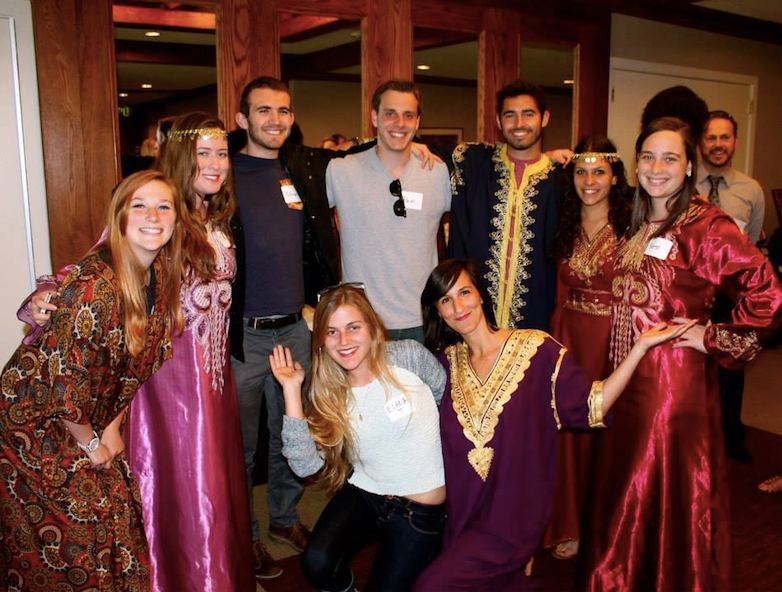Journey to the Mizrah
For Formal and Informal Educators
Across the board, we are seeing Sephardic, Mizrahi and Israeli students increase their enrollment in Jewish schools and their participation in Jewish life – yet Jewish schools and learning institutions are still catching up to meet the needs of shifting student bodies. Because so little research has been done on the contemporary, demographic trends of Mizrahi and Sephardic Jews – we rely heavily on anecdotal research. We know for example, that one in four students at the Jewish Community High School of the Bay identifies as Sephardic through a parent or grandparent. We know that Sephardic students are becoming an increasing majority at Jewish Day Schools in Los Angeles and New York. For example, Yeshiva of Flatbush – a modern orthodox, historically Ashkenazi school with over 10,000 students in Brooklyn, New York is now 95% Sephardic.
Despite shifting demographics, to date, the study of Mizrahi and Sephardic Jewish heritage has not been integrated as a regular component of Jewish day schools. As North America’s Jewish community becomes more diverse, it is essential that our Jewish schools receive high-level content and support to begin fully integrating Sephardic Studies into their regular Jewish history surveys, curriculum, and school activities.
JIMENA’s Journey to the Mizrah initiative serves as a replicable national model of an inclusive Jewish educational program that embraces and reflects the Jewish diversity of our own shifting communities, while educating and empowering Jewish educators and students on Jewish diversity and Sephardic Studies.
Incorporating modulated Sephardic Studies into Jewish Day Schools and informal education programs will broaden and strengthen students’ knowledge, understanding and language around issues of Jewish diversity, Jewish and Middle Eastern demographics and values, and contemporary Jewish identities and experiences. It will teach on the vibrant Jewish rituals and traditions of tolerance, inclusivity, and spiritual flexibility which are core components of Sephardic and Mizrahi heritage. Regardless of family background, all students, but particularly those who identify as the “other”, will be given a safe classroom space to explore and share their Jewish identities and backgrounds.
Journey to the Mizrah Workshop
The integration of Sephardic heritage into formal and informal Jewish learning spaces can broaden and strengthen students’ knowledge, understanding and language around issues of Jewish diversity, Jewish values and contemporary Jewish identities and experiences. This workshop invites Jewish educators to learn how Sephardic studies can teach on the vibrant Jewish rituals and traditions of tolerance, inclusivity and spiritual flexibility, which are core components of Sephardic heritage. This conference provides information and tools for educators and community leaders to create an inclusive platform for students to answer questions of how to navigate assimilation, issues of personal and communal identity and increasingly diverse Jewish spaces. Together participants explore Sephardic heritage and the needs and opportunities of Sephardic studies.
Past workshop sessions included: The Story of Sephardic Jews in America, Food and the Sephardic Story, Sephardic Spiritual Responses to Contemporary Issues Facing our Youth, Piyut Workshop, The Value of Sephardic Education, North African Holocaust Experience, The Devaluation of Minority Experiences at Jewish Day Schools, Pedagogy and Practical Application of Sephardic Studies in the Classroom, Journey into the Mizrah Curriculum.
Journey to the Mizrah Curriculum
In the Spring of 2019, JIMENA will launch our Journey to the Mizrah Curriculum and our website, journeytothemizrah.org. The curriculum was created by Sephardic thought leaders and educators and provides readers with lists of international resources on the subject, Sephardic texts, twelve lesson plans, and historical and contemporary information on Sephardic and Mizrahi Jews. We would like to provide ongoing support and curriculum evaluation for educators and schools wishing to integrate the curriculum into their classroom spaces. We also hope to continue developing the curriculum. Lesson plans include:
Around the Middle Eastern Jewish World Provides students with an overview of Sephardic and Middle Eastern Jewry. Students will understand how Sephardic and Mizrahi Jews came to exist as groups and will learn cultural and ethnic indicators of these groups.
Celebrating Sephardic Clothing Introduces students to Sephardic rituals where special clothing is worn. Students will be able to articulate the values that inspire these clothing traditions and be given the opportunity to try on a kaftan.
Forgotten Refugees Students will learn the term “refugee” by being introduced to the individual stories of Jewish refugees from North Africa and the Middle East. Students celebrate the lives and contributions of former Jewish refugees from Arab countries.
Henna Party An Immersive mock henna ceremony provides students the opportunity to learn about North African and Yemenite henna traditions.
Open Your Hand – HAMSA Primer into Sephardic and Mizrahi symbolism and values by focusing on the open hand. Students will create their own Hamsa to take home.
Middle Eastern Jewish Cuisine In this session students will learn about Sephardic and Mizrahi food and will ask the question: What makes food Jewish? What Jewish foods do we know and which foods are new to us?
Hafla! The Roots of Mizrahi Music Introduces students to the origins of Mizrahi music. Students will listen to several songs and will learn how to sing a classic Piyut or Jewish liturgical song according to the Yemenite tradition.
Oral Histories Presents the stories of Middle Eastern Jewish refugees and introduces students to the benefit and techniques of collecting and preserving family stories.
Photomapping A school-wide map activity introduces students to their classmates’ countries of origin.
Sephardic Storyteller Students will experience the beauty and wealth of Sephardic and Mizrahi folktales and will get to
Our Names, Our Identity In this session students will learn about the meaning of names in the creation of identity and will participate in activity to honor their family names and the family names of those different from them.
My Heart is the in East: Mizrahi Museum An exploration of student family heirlooms and on opportunity for students to present their family’s culture to the student body. Students will create an exhibit of their family heritage.
Young Adult and Educator Learning Series: Contemporary Issues through a Sephardic Lens
This scalable series originally consisted of four intimate sessions through which personal and contemporary issues were examined through the lens of Sephardi and Mizrahi Jewish texts. Past sessions included: Intersectionality and Authenticity through a Mizrahi Lens, Stories of Mimouna: Welcoming in Guests and Coexistence, Names and Identity, and Women’s Empowerment. The course was led in San Francisco and facilitated by a highly-experienced Sephardic educator and social worker who graduated from the Joint Program at Columbia University and the Jewish Theological Seminary of America and received a Masters degree in Social Work from Wurzweiler School of Social Work at Yeshiva University. We would like to expand this program into an ongoing series for Jewish educators that meets virtually, once an month.
For more information, please contact us.




